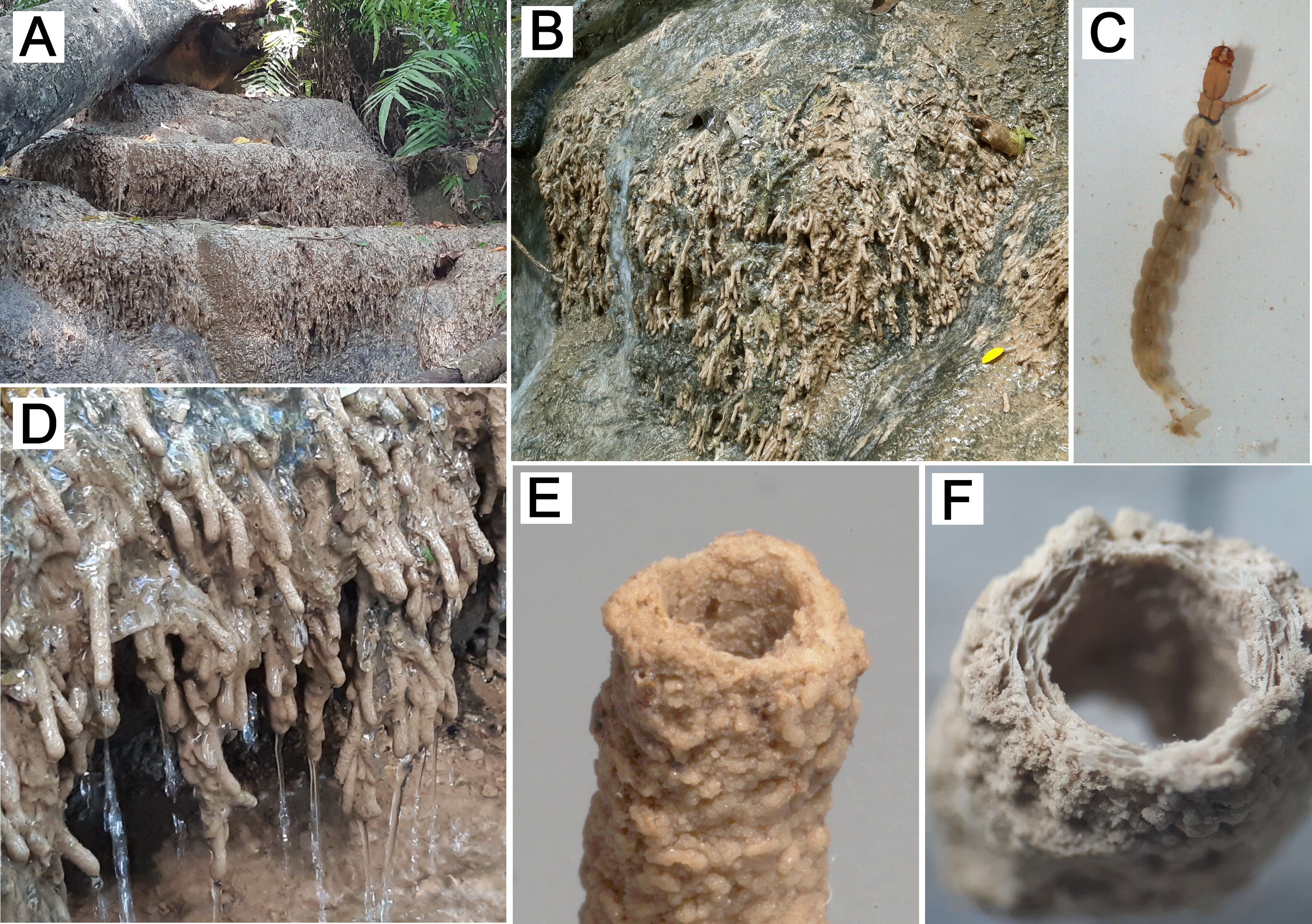Biomediation of Tufa Formation by Silk Capture Nets of Larval Philopotamidae (Insecta: Trichoptera)
References
1. Ridl, A., Vilenica, M., Ivković, M., Popijač, A., Sivec, I., Miliša, M. and Mihaljević, Z. 2018. Environmental drivers influencing stonefly assemblages along a longitudinal gradient in karst lotic habitats. Journal of Limnology, 77: 412–427.
2. Kvifte, G.M. and Ivković, M. 2018. New species and records of the Pericoma trifasciata group from Croatia (Diptera: Psychodidae). Zootaxa, 4486: 76–82.
3. Šemnički, P., A. Previšić, M. Ivković, K. Čmrlec and Mihaljević, Z. 2012. Tufa barriers from a Caddisfly’s point of view: Streams or Lake outlets? International Review of Hydrobiology, 97: 465–484.
4. Ivković, M., Miliša, M. and Mihaljević, Z. 2010. The aquatic dance flies fauna (Diptera, Empididae: Hemerodromiinae and Clinocerinae) of the Plitvice Lakes National Park. Natura Croatica, 19: 133–139.
5. Ben Ahmed, W., Henchiri, M., Mastouri, A. and Slim S’himi, N. 2018. Calcified aquatic insect larval constructions in the Pleistocene tufa of Jebel El Mida, Gafsa, southern Tunisia: Recognition and paleoenvironmental significance. Journal of African Earth Sciences, 140: 256–266.
6. Martín-Algarra, A., Martín- Martín, M., Andreo, B., Julía, R. and González-Gómez, C. 2003. Sedimentary patterns in perched spring travertines near Granada (Spain) as indicators of the paleohydrological and paleoclimatological evolution of a karst massif. Sedimentary Geology, 161: 217–228.
7. Zhang, D.D., Zhang, Y., Zhu, A. and Cheng, X. 2001. Physical methods of river waterfall tufa (travertine) formation. Journal of Sedimentary Research, 71: 205–216.
8. Pedley, M., Rogerson, M. and Middleton, R. 2009. Freshwater calcite precipitates from in vitro mesocosm flume experiments: a case for bio-mediation of tufas. Sedimentology, 56: 511–527.
9. Kepčija R.M., Habdija, I., Primc-Habdija, B. and Miliša, M. 2006. Simuliid silk pads enhance tufa deposition Archiv für Hydrobiologie, 166: 387–409.
10. Loewen, M.A., Leggitt, V.L. and Buchheim, H.P. 1999. Caddisfly (Trichoptera) larval cases from Eocene Fossil Lake, Fossil Butte National Monument. In: Santucci, V.L. and McClelland, L. National Park Service Paleontological Research Volume 4, Technical Report NPS/NRGRD/ GRDTR 99/03, United States Department of the Interior, National Park Service, Geological Resources Division, Lakewood, USA. pp 72–77.
11. Leggit, V.L. and Cushman, R.A. 2001. Complex caddisfly-dominated bioherms from the Eocene Green River Formation. Sedimentary Geology, 145: 377–396.
12. Carthew K.D., Russell, N., Drysdale, R.N. and Taylor, M.P. 2002. Tufa deposits and biological activity, Riversleigh, Northwestern Queensland. In: Roach, I.C. ed. Advances in Regolith,. Cooperative Research Centre for Landscape Environments and Mineral Exploration. Bentley, Australia. pp. 55-59
13. Wallace, J.B. and Malas, D. 1976. The fine structure of capture nets of larval Philopotamidae (Trichoptera), with special emphasis on Dolophilodes distinctus. Canadian Journal of Zoology, 54: 1788–1802.
14. Drysdale, R.N. 1999. The sedimentological significance of hydropsychid caddisfly larvae (Order: Trichoptera) in a travertine-depositing stream: Louie Creek, Northwest Queensland, Australia. Journal of Sedimentary Research, 69: 145–150.
2. Kvifte, G.M. and Ivković, M. 2018. New species and records of the Pericoma trifasciata group from Croatia (Diptera: Psychodidae). Zootaxa, 4486: 76–82.
3. Šemnički, P., A. Previšić, M. Ivković, K. Čmrlec and Mihaljević, Z. 2012. Tufa barriers from a Caddisfly’s point of view: Streams or Lake outlets? International Review of Hydrobiology, 97: 465–484.
4. Ivković, M., Miliša, M. and Mihaljević, Z. 2010. The aquatic dance flies fauna (Diptera, Empididae: Hemerodromiinae and Clinocerinae) of the Plitvice Lakes National Park. Natura Croatica, 19: 133–139.
5. Ben Ahmed, W., Henchiri, M., Mastouri, A. and Slim S’himi, N. 2018. Calcified aquatic insect larval constructions in the Pleistocene tufa of Jebel El Mida, Gafsa, southern Tunisia: Recognition and paleoenvironmental significance. Journal of African Earth Sciences, 140: 256–266.
6. Martín-Algarra, A., Martín- Martín, M., Andreo, B., Julía, R. and González-Gómez, C. 2003. Sedimentary patterns in perched spring travertines near Granada (Spain) as indicators of the paleohydrological and paleoclimatological evolution of a karst massif. Sedimentary Geology, 161: 217–228.
7. Zhang, D.D., Zhang, Y., Zhu, A. and Cheng, X. 2001. Physical methods of river waterfall tufa (travertine) formation. Journal of Sedimentary Research, 71: 205–216.
8. Pedley, M., Rogerson, M. and Middleton, R. 2009. Freshwater calcite precipitates from in vitro mesocosm flume experiments: a case for bio-mediation of tufas. Sedimentology, 56: 511–527.
9. Kepčija R.M., Habdija, I., Primc-Habdija, B. and Miliša, M. 2006. Simuliid silk pads enhance tufa deposition Archiv für Hydrobiologie, 166: 387–409.
10. Loewen, M.A., Leggitt, V.L. and Buchheim, H.P. 1999. Caddisfly (Trichoptera) larval cases from Eocene Fossil Lake, Fossil Butte National Monument. In: Santucci, V.L. and McClelland, L. National Park Service Paleontological Research Volume 4, Technical Report NPS/NRGRD/ GRDTR 99/03, United States Department of the Interior, National Park Service, Geological Resources Division, Lakewood, USA. pp 72–77.
11. Leggit, V.L. and Cushman, R.A. 2001. Complex caddisfly-dominated bioherms from the Eocene Green River Formation. Sedimentary Geology, 145: 377–396.
12. Carthew K.D., Russell, N., Drysdale, R.N. and Taylor, M.P. 2002. Tufa deposits and biological activity, Riversleigh, Northwestern Queensland. In: Roach, I.C. ed. Advances in Regolith,. Cooperative Research Centre for Landscape Environments and Mineral Exploration. Bentley, Australia. pp. 55-59
13. Wallace, J.B. and Malas, D. 1976. The fine structure of capture nets of larval Philopotamidae (Trichoptera), with special emphasis on Dolophilodes distinctus. Canadian Journal of Zoology, 54: 1788–1802.
14. Drysdale, R.N. 1999. The sedimentological significance of hydropsychid caddisfly larvae (Order: Trichoptera) in a travertine-depositing stream: Louie Creek, Northwest Queensland, Australia. Journal of Sedimentary Research, 69: 145–150.

Downloads
Published
2019-09-30
How to Cite
[1]
Plant, A.R. 2019. Biomediation of Tufa Formation by Silk Capture Nets of Larval Philopotamidae (Insecta: Trichoptera). Tropical Natural History. 19, 2 (Sep. 2019), 113–116.
Issue
Section
Short Notes
License
Chulalongkorn University. All rights reserved. No part of this publication may be reproduced, translated, stored in a retrieval system, or transmitted in any form or by any means, electronic, mechanical, photocopying, recording or otherwise, without prior written permission of the publisher







